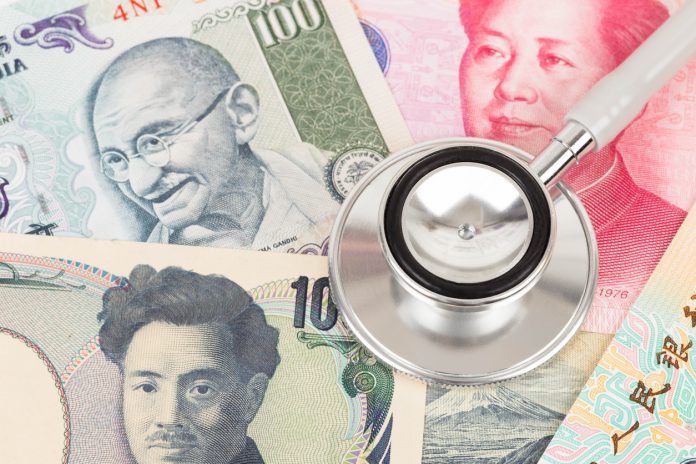Debarati Sengupta, Research Manager at Advanced SciTech in the Everest Group, analyses evolving healthcare in Southern and Southeast Asia
The emerging economies of Southern and Southeast Asia (India, Indonesia, Malaysia, the Philippines, and Thailand) are undergoing rapid transformations in demographics, technological innovations, socioeconomic development, and consumer expectations. These transformations have changed health priorities over the last several years.
Asia is facing an unprecedented increase in the ageing population. With old age comes several complex health challenges, such as osteoarthritis, chronic obstructive pulmonary disease, diabetes, and dementia. 2022 Statistics by the United Nations predict that by 2050, Asia will be home to 1.3 billion people aged 60 and older, which is approximately one in every four people. A 2024 report from Old Age Poverty and Active Ageing in ASEAN (Association of Southeast Asian Nations) states the elderly population (60 years and older) will grow from 77.4 million in 2020 (11.5% of the population) to 173.3 million (22.0%) by 2050, making it one of the fastest demographic transitions globally.
This ageing society with growing comorbidities is causing strain on healthcare systems. The changing socioeconomic landscape has led to longer lives, but there has also been a growth in non-communicable diseases (NCDs). A World Health Organization fact sheet reveals that 62% of all deaths in Southeast Asia (around 9 million people) are due to NCDs, mainly cardiovascular diseases, cancer, diabetes, and chronic respiratory diseases.
Beyond these significant demographic and epidemiological challenges, the disparity in healthcare accessibility, especially in rural areas, is another challenge these emerging nations still face. The healthcare systems are also dealing with financial challenges. Low public health financing causes infrastructure deficits, significant out-of-pocket expenditures, and a lesser scope for clinical research.
According to the 2024 report in the Asia Pacific Journal of Public Health, in 2021, South Asia had the second lowest level of universal health coverage (UHC) and the highest level of catastrophic health spending compared to other regions globally. The COVID-19 pandemic during this time exposed the inadequacy of the healthcare systems in South Asia. In this region, the healthcare system is a mix of private and public healthcare providers. Most of these emerging economies focus on curative medicine and heavily depend on private care providers. However, this scenario is slowly changing with the increasing public health investment.
Improvements in primary healthcare, public health policies, and novel healthcare models are driving change in the healthcare system. These reforms pave the way for a more accessible, patient-centered healthcare system. Some evolving healthcare system trends and key initiatives by the emerging South Asian economies are discussed below.
Trends shaping the healthcare system of emerging economies
1. Improvement in government healthcare financing
It is a known fact that government financing for healthcare is critical for improving health accessibility and affordability. Over the last decade, India and Southeast Asian emerging economies have witnessed monumental government policy changes and increased government health expenditures. This has directly resulted in tangible benefits, such as reduced mortality rates (infant, child, and maternal). Some examples of public health financing by these emerging nations are given below.
The National Health Insurance, Jaminan Kesehatan Nasional (JKN) scheme by the Government of Indonesia, offers UHC, covering more than 95% of the population (approximately 260 million). This scheme has reduced out-of-pocket expenses and catastrophic health expenditures (4.5% of current health expenditure in 2017 to 2% in 2021).
For 2025, the Government of Malaysia allocated RM45.3 billion to healthcare, a 10% increase from the 2024 allocation of RM41.2 billion. Most of the budget will fund upgrading old clinics, especially in rural areas, to strengthen the public health system. This will help the government address the challenge of urban-rural disparities and provide care to a growing patient population due to the high prevalence of chronic diseases and comorbidities associated with ageing.
India has also increased its total health expenditure per capita. According to the Government of India Press Release, the share of government health expenditure in total health expenditure increased from 29% in 2015 to 48% in 2025. To improve health equity, the government has introduced Ayushman Bharat – Pradhan Mantri Jan Arogya Yojana (AB – PMJAY), which offers health coverage to the economically backward population. This has led to a significant drop in out-of-pocket expenditure (reports suggest savings of ₹1.25 lakh crore).
However, despite several efforts, the healthcare financing gap is still high. This is because of the growing healthcare inflation rate, which is generally triple that of general inflation. This is causing a disparate increase in healthcare costs. For example, though the healthcare budget allocated by Malaysia’s Ministry of Health has increased from RM25 billion in 2017 to RM41.2 billion in 2024, this is still considered underinvestment. To meet the 5% of GDP target for health allocations, at least RM85 billion would need to be allocated, which is more than a 100% increase from current levels and 22% of this year’s entire federal budget. This showcases that though the governments are making strides in healthcare financing, it is still insufficient to meet the growing demands.
2. Embracing digital revolution
The digital revolution in emerging economies has positively impacted businesses, systems, and services. Digitalisation is one of the critical drivers for economic growth. In Southeast and South Asia, with their colossal disease burden, vast population, and disparities in healthcare, digital healthcare innovation has become imperative to address these unique challenges.
Digital platforms like telemedicine, mobile health applications, and remote diagnostic tools can improve healthcare accessibility. Digital health transformation also tackles issues such as inefficient healthcare systems, limited resources, and rising healthcare costs.
The significant disease burden can be managed with AI-enabled digital tools, such as early diagnosis platforms, personalised treatment plans, or real-time disease surveillance. The digital revolution in administrative tasks improves efficiency and reduces operational costs. AI-based decision-making platforms streamline the workflow and address staff shortage problems if there are any. Most emerging economies embrace digital transformation for better access and streamlined healthcare systems.
India is trying to digitalise the entire healthcare ecosystem by creating a unified digital infrastructure called Ayushman Bharat Digital Mission (ABDM). As per the latest media reports, over 76 crore Ayushman Bharat Health Accounts have been created, and more than 5.95 lakh verified healthcare professionals and 3.86 lakh verified health facilities have registered.
Other digital interventions include the National Telemedicine Service, one of the world’s largest telemedicine platforms, E-Sanjeevani, for primary care, offering remote consultations to over 36 crore patients. Through 1.76 lakh Ayushman Arogya Mandirs (Health & Wellness Centres for comprehensive primary care), 107.10 crore screenings for hypertension and 94.56 crore screenings for diabetes have been conducted. As part of the Universal Immunization Programme (UIP) – one of the world’s most extensive immunisation programmes – the digital U-WIN platform is used to streamline and track immunisation for pregnant women and children.
In Thailand, the government upgraded its UHC programme. Launched in January 2025, the upgraded UHC includes a personal digital health ID for streamlined, accessible, and efficient care. This ID will have patient information (including patient history) in a single, secure digital platform for better care coordination between doctors, specialists, and hospitals. It also includes online consultations, booking appointments, digital referrals, and pharmacy services.
In 2023, the Malaysian Parliament approved the Ministry of Health’s Health White Paper, which emphasises electronic medical records and health information exchange. The government has earmarked 31 million USD (RM150 million) to improve the Ministry of Health’s (MOH) information technology systems and position Clinic Management System Subscriptions in 100 health clinics.
Transform Health Indonesia, an initiative by the government and other health partners, aims to digitalise completely and have an integrated primary healthcare system by 2030. This will include integrated and interoperable health data, such as Electronic Patient Health Records (ePHR), and a digitally enabled health workforce.
The Philippines Department of Health discusses the importance of leveraging digital health and technology, such as the interoperability of digital health information systems, for efficient and accessible health service delivery.
3. Wellness and preventative care
With the increasing interest and financing by the governments of emerging nations in South Asia, the focus is slowly shifting from curative care to health promotion and disease prevention. This is primarily to address the growing crisis of NCDs and the preventable mortality associated with them.
In February 2025, the Indonesian Government started the nationwide NCDs screening programme called Pemeriksaan Kesehatan Gratis (PKG). This annual screening includes all Indonesians, from newborns to older people. The PKG is a government initiative of 3 trillion rupiah (USD 183.54 million).
In India, initiatives such as Rashtriya Bal Swasthya Karyakram (RBSK) (preventing health complications by providing early screening and intervention to children) and Rashtriya Kishor Swasthya Karyakram (RKSK) (promoting wellness in adolescent population) are supported by the Ministry of Health and Family Welfare and the Ministry of Education, Government of India.
In collaboration with the World Health Organization, the Malaysian Health Ministry has initiated a comprehensive healthcare education programme to increase awareness about diseases and early intervention and promote preventative care.
Recently, Indonesia allocated 3 trillion rupiah (USD 183.54 million) for annual free health check-ups to prevent early deaths from stroke, heart disease, and tuberculosis.
Thailand is home to a robust wellness economy, with medical wellness facilities offering comprehensive preventive check-ups and wellness retreats (targeting longevity, fertility, heart and brain wellness, etc.). These wellness centres in Thailand mostly cater to the health tourism market.
4. Focus on elderly care
Although the youth bulge drives economic growth in Southern and Southeast Asia, this region also has a rapidly growing ageing population. To put things in perspective, UNFPA (United Nations Population Fund) statistics show that the elderly population in South Asia aged 80 years and older was almost 6 million from 1950-2000, will exceed 14 million from 2000-2025, and will triple to almost 42 million from 2025-2050. Health systems are giving importance to the healthcare needs of the ageing population.
In India, currently, 10.5% of the population (149 million people) are 60 and above; by 2050, it is expected to reach 20.8% of the population (347 million people). The Government of India’s Pradhan Mantri Jan Arogya Yojana (PM-JAY) is the world’s largest government-financed health insurance/assurance scheme where senior citizens aged 70 or above, regardless of economic status, are eligible for free medical treatment up to ₹5 lakh per year for hospitalisation in secondary and tertiary care hospitalisation across public and private empanelled hospitals in India.
In Malaysia, under the Bantuan Keluarga Malaysia scheme, in addition to giving direct cash aid to Malaysian households, the Budget 2022 introduced a cash aid of RM300 for older adults aged 60 years and older.
However, senior-specific institutional care is sparse. Example: Thailand’s Universal Coverage Scheme does not currently cover institutional long-term care (mainly required for older people) due to its high cost. This creates business opportunities for aged or institutional care in these regions.
Analysis of the healthcare system in emerging economies
The health systems of emerging and developing countries in Southern and Southeast Asia vary depending on the country’s economic development and political systems.
India: India’s diverse and complex health system has a network of public and private hospitals. The system has challenges, including urban-rural disparities, the growing burden of NCDs, and limited insurance coverage. The Indian healthcare system is undergoing significant transformations, such as digitalisation, offering low-cost medical devices and procedures. Several government policies and schemes as Janani Shishu Suraksha Karyakram (JSSK) (providing free medicines diagnostics) or RBSK (newborn and child health screening and early interventions services for congenital disabilities, diseases, deficiencies and developmental delays to improve the quality of survival), Rastriya Arogya Nidhi (RAN) (providing financial assistance to below poverty line patients suffering from major life-threatening diseases), the Health Minister’s Cancer Patient Fund (HMCPF) (providing financial assistance to patients below the poverty line suffering from life threatening diseases) and many more such policies have created a positive impact in providing equitable, affordable and quality healthcare services.
Thailand: It has one of the best healthcare systems, with both private and public settings. Its tax-funded UHC scheme’s public health system covers 99.5% of residents, providing them with healthcare services with no out-of-pocket costs. The Universal Coverage Scheme recently prioritised implementing digital technologies into the healthcare system, focusing on elderly care, disease prevention, mental health services, and addiction recovery programmes. This strong public health system has decreased infant mortality, increased life expectancy, improved two-year survival rates for cancer and heart attacks, and improved care accessibility in rural areas. Though the government is spending a high share on health, this might not be easy to sustain in the long term. The government is trying to curb costs through disease prevention and promotion programmes. The private hospitals are mainly in urban areas and are crucial in filling the gaps in public health services.
Malaysia: It also has a dual healthcare system, heavily subsidised, centralised, government-funded, public sector healthcare catering to more than 65% of the population and a well-established private sector. The healthcare system also promotes medical tourism, providing access to top-quality care for fee-paying patients. Though urban areas have the best healthcare types, rural areas have basic care and don’t have access to specialist care. Rural and urban public hospitals also have a severe shortage of healthcare workers.
Indonesia: The Indonesian health system has a mix of public and private providers and financing. A decentralised government administers the public health system. In addition to public and private hospitals, Indonesia also has primary healthcare and vaccination centres called Public Health Community Centers, or PUSKESMAS. One of the major challenges is the disparity in Indonesia’s public and private healthcare systems. Most private hospitals in Jakarta use modern technologies, and most public hospitals are in rural parts of Indonesia. These public hospitals need modernisation and better investments.
Philippines: The public healthcare system in the Philippines has disparities across rural and urban areas; private healthcare has high-quality health systems and is more reliable than public ones. Philippines Health Insurance Corporation – PhilHealth aims to provide universal health coverage. PhilHealth covers inpatient and outpatient care, diagnostic testing, and preventative services. In 2025, its newly launched benefit packages focus on patient-centric healthcare services. The premium for this insurance depends on income.
Analyst viewpoints and strategic growth avenues
The emerging economies of Southern and Southeast Asia are experiencing inequitable socioeconomic development and rising inflation, with massive demographic and epidemiological transitions, such as the rise of NCDs and an ageing population. Though every government strives to offer UHC, growing demands force it to prioritise its resources and challenge the long-term resilience of UHC. This has increased healthcare disparities in some economies, increasing the challenges for healthcare systems. Many Southeast
Asian economies are struggling with a relatively underdeveloped public healthcare system. In India, the sizeable demand-supply disparity also creates a gap in care delivery. Some of the ways to close this gap in care delivery and offer efficient and quality care are given below:
Public-private collaborations: Increasing public healthcare financing, improving policies, and introducing health reforms are essential to meet the growing demand. The corporatisation of public health systems can improve care delivery efficiency while maintaining public service ethos. Private healthcare systems are inevitably essential for managing the healthcare gap. To manage out-of-pocket expenditures, the government can introduce a scheme or a public body to review charges imposed by private hospitals or health insurers. The government can also integrate the private sector into public health strategies to improve care accessibility.
Integrated care with omnichannel experience: Integrated care can minimise redundant processes and optimise resource utilisation, improve communication between doctors, hospitals, diagnostic centres, etc., and thus improve the system’s efficiency. Integrating digital technologies that enable data interoperability can help achieve that goal. Enhancing digital literacy in healthcare workers is imperative for them to use and implement these new platforms and reduce the administrative burden. Digital technologies can help create a holistic omnichannel care experience for healthcare consumers. AI-based health analytics, healthcare education, and self-management platforms are some ways to create omnichannel engagement.
References
- Sharma, Jalendra, Milena Pavlova, and Wim Groot. 2024. “Challenges and
Opportunities for Universal Health Coverage in South Asia: A Scoping Review.”
Health Promotion International 37 (1). https://doi.org/10.1177/10105395241296653 - Li, Zhuzhou. 2024. “Session 4: “Population Aging and Living Arrangements in
Asia: Facts, Observations, and Responses” United Nations Department of
Economic and Social Affairs. https://social.desa.un.org/sites/default/files/inline-files/Session%204_Shuzhuo%20Li.pdf - ASEAN. 2024. “Old Age Poverty and Active Ageing in ASEAN: Trends and
Opportunities.” Association of Southeast Asian Nations (ASEAN).
https://asean.org/wp-content/uploads/2024/07/Old-Age-Poverty-and-Active-Ageing-in-ASEAN-Trends-and-Opportunities-250724.pdf - World Health Organization (WHO). 2024. “Noncommunicable Diseases.”
World Health Organization, Regional Office for Southeast Asia.
https://www.who.int/southeastasia/health-topics/noncommunicable-diseases - Dhillon, I., Jhalani, M., Thamarangsi, T., Siyam, A., & Khetrapal Singh, P. (2023).
Advancing universal health coverage in the WHO South-East Asia Region with a
focus on human resources for health. The Lancet Regional Health – Southeast
Asia, 18, 100313. https://www.thelancet.com/journals/lansea/article/PIIS2772-3682(23)00173-7/fulltext - Press Information Bureau (PIB). 2024. “Total Health Expenditure per Capita
Increases by 48.0%.” Press Information Bureau, Government of India.
https://pib.gov.in/PressReleaseIframePage.aspx?PRID=2097868 - Institute Jantung Negara (IJN). 2024. “Malaysia’s Healthcare Expenditure
To Increase At CAGR Of 8.7% Till 2028: BMI.” Institut Jantung Negara.
https://www.ijn.com.my/6041-2/ - DD News. 2025. “WHO Highlights Maternal and Newborn Health on World
Health Day 2025; India Leads Regional Efforts toward Resilient Healthcare.” DD
News, April 7, 2025. https://ddnews.gov.in/en/who-highlights-maternal-andnewborn-health-on-world-health-day-2025-india-leads-regional-efforts-towardresilient-healthcare/ - P4H Network. 2024. “Health Care Financing Strategy of the Philippines
2023-2028 Towards Universal Health Care.” P4H Network. Accessed April 12,
2025. https://p4h.world/app/uploads/2024/06/Health-Care-Financing-Strategy-the-Philippines-2023-2028.x23411.pdf - United Nations Population Fund (UNFPA). Ageing. Accessed April 12, 2025.
https://www.unfpa.org/ageing - Khaosod English. 2024. “Thai Healthcare Upgraded to ‘30 Baht
Treat Anywhere’ System.” Khaosod English, December 25, 2024.
https://www.khaosodenglish.com/politics/2024/12/25/thai-healthcare-upgraded-to-30-baht-treat-anywhere-system/ - The Lancet Regional Health – Southeast Asia. 2023. “Non-communicable
Diseases in South-East Asia: Journeying Towards the SDG Target.” The Lancet
Regional Health – Southeast Asia. https://www.thelancet.com/journals/lansea/article/PIIS2772-3682(23)00165-8/fulltext - The Lancet Global Health. 2025. “Indonesia’s First Nationwide Health
Screening Programme.” The Lancet Global Health 13 (1): e4–e5.
https://doi.org/10.1016/S2214-109X(25)00071-3 - YCP. 2023. “Digital Health Transformation in Thailand – Drivers & Barriers.”
YCP, July 31, 2023. https://ycp.com/insights/article/thailand-digital-healthcare-technologies-opportunities - Dharmaraj, Samaya. 2024. “Thailand: Digital Transformation Advances
Healthcare Access.” OpenGov Asia, December 26, 2024. - World Health Organization & International Bank for Reconstruction and
Development / The World Bank. (2023). Tracking universal health coverage:
2023 global monitoring report. World Health Organization. https://iris.who.int/bitstream/handle/10665/374059/9789240080379-eng.pdf?sequence=1 - Press Information Bureau. (2025, April 6). World Health Day 2025:
Strengthening Indian healthcare for a resilient future. Ministry of Health and
Family Welfare, Government of India. https://static.pib.gov.in/WriteReadData/specificdocs/documents/2025/apr/doc202546535301.pdf - United Nations Population Fund (UNFPA) India. (2023, September 27).
India ageing, elderly to make up 20% of population by 2050: UNFPA report.
https://india.unfpa.org/en/news/india-ageing-elderly-make-20-population-2050-unfpa-report











